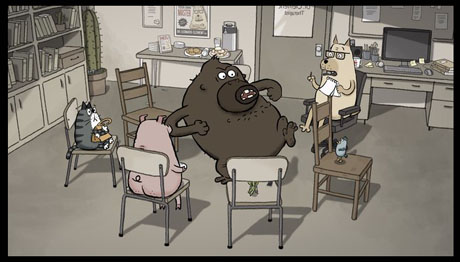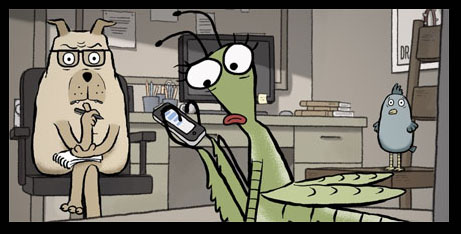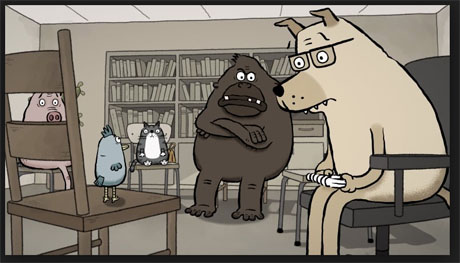
The husband-wife duo of David Fine and Alison Snowden won an Oscar for their animated short, “Bob’s Birthday” in 1995. The Canadian couple is in contention for a second this year with the creature comedy, Animal Behaviour.
Jackson Murphy: Was it a different experience finding out the news this time?
Alison Snowden: It was a bit more low-key last time.
David Fine: Last time, there was no internet. No social media. We were in England at the time. I can’t remember… what time would that have been? Some stupid hour. Whereas here (now), we watched it live-streaming in our pajamas. And actually, The Academy asked the shortlisted people to video themselves watching it. So we thought, “Alright. We’ll do that.” So we did that, and The Academy used that online, which was kind of funny – because we’re sitting in our pajamas watching the nominations.

JM: So you had to look at least halfway decent because you were filmed. I was surprised when I saw some nominees had recorded themselves. If you didn’t get the nomination that becomes a weird thing. It’s good you guys got the nomination.
DF: Yeah, that would be very quickly deleted.
JM: I watched your acceptance speech from 25 years ago online the other day. First of all… I was not alive 25 years ago. I love the fact that Bugs Bunny and Daffy Duck presented your award. That must’ve been a wild night for you. Having those characters present your category must’ve been amazing.
DF: Well it was kind of disconcerting because on-stage of course, and I hate to break it to you, they’re not real. (laughs) So you’re looking at the monitors watching it happen. And the voice actor, who was Mel Blanc’s son, actually… he was backstage. And he literally opened the envelope live. And in the animation, you may notice that when Bugs Bunny says, “And the award goes to…”, he lifts the envelope over his mouth so you can’t see the lip-sync. And then the voice actor [Noel Blanc] opened the envelope backstage for real and said, “Bob’s Birthday”! That was a very strange experience because it wasn’t a human being on stage doing it.
And then as we walked off the stage… [Blanc] handed us the envelope and said, “Maybe you want this souvenir.” So we got the envelope, which was really sweet of him.
JM: Wow. Do you go back and watch the speech on YouTube often?
AS: Not at all.
DF: Well I’ve seen it, but I can’t say I watch it very regularly.
JM: What would you say has changed in the animation world – from your experience – over the last quarter century?
AS: Technology has changed. We didn’t have 3D animation back then.
DF: Not to speak of. CGI was in its infancy.
AS: So it was mostly all 2D films. Obviously how you produce short films and features is different now. It’s all digitized. I don’t know if it makes it faster or easier but you can do more. So that opens up a whole new world. It’s easier for individuals to make a short film on their own… without funding. If you have the time. You can pretty well do everything yourself, whereas you used to have to go to cameramen and sound studios – all kinds of things to get your film finished.
DF: So access to making a film is certainly easier because it’s cheaper. Way cheaper. And you can get it out on YouTube and the world can see it, which is pretty amazing. You can say, “Hey – you wanna see my film? Here’s a link.” and send it to anyone. Before, you had to get it at festivals. We used to attend the Spike & Mike Festival down in California. That was a huge thing because people could see our film at this festival, where they get lots of big audiences. And it was wonderful, It’s still wonderful to see a film live on the big screen, for sure. And we’ve had the good fortune of having that happen at festivals with our latest film. But it’s also so easy to share with the world online, and that’s distinct now from back then.
JM: Do you think people should still come together to watch your short – and the other nominees – on the big screen as part of the Oscar Nominated Animated Short Films theatrical presentation, even though everyone has can access them online?
AS: Oh, I think so because… especially with a comedy, to watch with a live audience, I think it makes it much more enjoyable. But also to see all the animators that worked very hard on the visuals of their films – with the intention of them being projected. They look way better huge than on a tiny screen. You get more of that sense of a cinematic experience that way. And the sound as well, because you work hard on the music. You get the stereo sound.

JM: And this is one of the more ambitious animated shorts I’ve seen in a while in terms of a dialogue-based comedy. What did you use as inspirations for the humor in “Animal Behaviour”?
AS: I guess it comes a bit more from live-action. I think our writing does in general, really, because we met at film school, and we were both there with the intention of coming out as live-action directors. But we both ended-up sticking to animation in the end. Our first films were narrated or had no dialogue. We saw a short film called “The Big Sneer”, which was a couple arguing and we just thought we wanted to do dialogue, and it would feel more like live-action writing as well.
DF: And that’s way back. For this film in particular, we just came up with the notion for it – and it was what it was. So it was a dialogue-heavy film, but we weren’t setting out to do a dialogue-heavy film. It was just that we thought that this was a funny premise.
AS: We did think of “12 Angry Men” – all in one room, where basically one guy got a different opinion from everyone else. We often thought about that in terms of the drama.
JM: Have you always had a fascination with animals – their movements, their behavior – and wanting to turn them into talking characters?
AS: I do enjoy animating animals. There’s been a dog or some kind of animal – a bird – in pretty much every film that we’ve done. I do love observing animals and how they move. In terms of talking animals… I guess we’re always a big fan of Gary Larson, too. We’ve found his cartoons very funny. They were always often animals in human situations. It’s not like we ever thought, “We’re going to make a film about talking animals”. I think it all just came together.
JM: I really like the colors of the characters.
AS: I wanted to set a particular style for this film that was different from “Bob’s Birthday”. That was all bright colors because it was gonna be a birthday party. And I wanted this to have a bit more of a serious tone, even though we are making fun of it. So I based it on a graphic novel look – a limited palette. Choosing the color of the pig – I wanted him to look funny with the pink, but at the same time not too pink – not too pretty. That took a bit of work, just to get everything balanced. You want the characters to pop and show up, but at the same time, you want it to have this… more of a graphic novel, low-key feel to it as well.
JM: I noticed in the credits that you dedicated this film to the doctors, nurses and staff at Vancouver General Hospital. Therapy is a pretty serious thing, and you balance the serious aspects with the comedy. Did you visit Vancouver General to get some perspective on patients in general?
AS: Well… while we were making the film, actually towards the end, I actually had a medical emergency and had to have a double lung transplant. I wanted to credit them because they really saved my life. They went to incredible lengths to do that. So I made them responsible for the finished product.
JM: Wow.

DF: The credit has nothing to do with research for the film. It was just because, as Alison says, they saved her life. And this was a sudden thing during the making of the film. She got a virus, and the virus destroyed her lungs. And she was in ICU in a coma for a month. And they saved her life. So we had to dedicate the film to them.
AS: A small thank you. (laughs)
DF: We do work with the Hospital Foundation because… we made this film and dedicated it, and it’s had festival success and the Oscars – the Foundation uses us as publicity to say, “Look what we do!” and everything. So we’re really happy to give back.
AS: I’ve been the poster girl for lung transplants. Also we like to raise awareness for donors because that’s what they desperately need – is everyone to fill out those donor cards.
DF: I like to say, “Be an organ donor – because a bit of you might end up in an Oscar nominee.”
JM: I’m so glad you’re doing well, Alison. That’s an unbelievable story. What do you hope audiences take away from one of the main themes of “Animal Behaviour”: animals behaving like humans and vice versa?
AS: We have different messages. One of them is how hard it is to change. If you go into therapy, it’s not an instant thing – walking out and feeling great. It’s a process. So that was one of the points. The other one is the question that comes up a lot for people: do you have to change to adapt to be accepted by people, or should people accept you for who you are? You often hear, “Oh, that’s the way they are. You just have to accept them for what they are.” It’s sort of a conversation that we wanted to spark, instead of us saying, “Oh, therapy’s amazing” or “Therapy’s got issues.” Just to discuss it.
JM: Do you think you might re-visit these characters with a follow-up to “Animal Behaviour” – see how they’re going with them a little bit down the line?
AS: We may do it in some form. We just finished the film and have been busy traveling and promoting the film. But certainly a lot of people have said they’d like to see more about these characters. So what forms that will take we haven’t totally explored yet.
DF: Right. But the question you asked has come up. People have seen the film and said, “Oh. Could this be a series? I want to know more about these characters.” We’re heartened that people feel invested in the characters that way – that they want to know more. That’s nice. So we’ll see what happens.
JM: Yeah. I could totally see this being something HBO would potentially do: a 10-episode season with these characters and this concept. I can definitely see that happening. Who are the people you’re most looking forward to seeing at the Academy Awards this time?
DF: Well when we went to the luncheon… we had the opportunity to meet some artists, which was kind of thrilling to bump into – as fans. Two people who weren’t there who we would be very keen to have a chance to meet and shake their hands would be the Coen Brothers. We love their work. They weren’t at the luncheon, but they’re nominated for Adapted Screenplay. That would be a thrill. Got to meet Spike Lee at the luncheon, which was amazing. We love his work. Richard E. Grant, we chatted with.
AS: And Melissa McCarthy.
JM: I’m glad the Coens are nominated. I loved “Buster Scruggs”.
AS: I am too. That was my favorite.
- INTERVIEW: “Inside Out 2” Director And Producer On Pixar Sequel - April 16, 2024
- INTERVIEW: “Puffin Rock And The New Friends” And 25 Years Of Cartoon Saloon - April 10, 2024
- INTERVIEW: “Chicken For Linda!” Directors On Annecy Winning Feature - April 9, 2024


 February 11th, 2019
February 11th, 2019  Jackson Murphy
Jackson Murphy  Posted in
Posted in  Tags:
Tags: 






